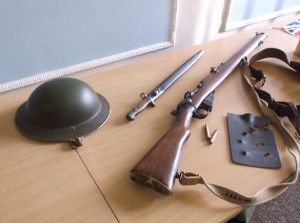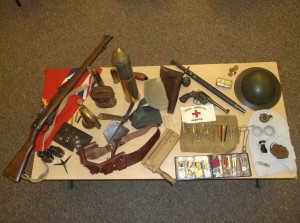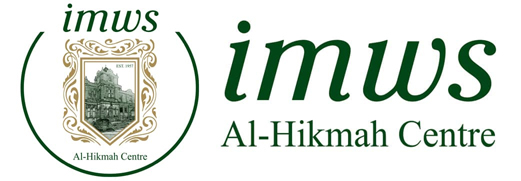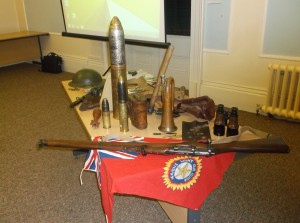 It was an enthralling evening in the crowded quarter of Bayt-ul-Hikmah’s Al-Rumi conference suite. The afternoon session with primarily school children in key stage 3 and 4 had climaxed and it was now time for the evening session. But little did we realise exactly how eye-opening this walk through history was about to be, as Jahan Mahmood’s Travelling Military Museum came to the Al-Hikmah Centre.
It was an enthralling evening in the crowded quarter of Bayt-ul-Hikmah’s Al-Rumi conference suite. The afternoon session with primarily school children in key stage 3 and 4 had climaxed and it was now time for the evening session. But little did we realise exactly how eye-opening this walk through history was about to be, as Jahan Mahmood’s Travelling Military Museum came to the Al-Hikmah Centre.
The early arrivals had already crowded around the table at the front. On it sat military artefacts dating back to the First and Second World Wars. Artefacts that certainly looked familiar from period documentaries and programmes, but for the first time we were able to hold the de-activated weapons and take a closer look at equipment dating back a hundred years.
An Enfield MK3 rifle with bayonet; a Smith and Wessen hand gun; a soldiers helmet; a pair of binoculars; an early gas mask; a hand grenade – to name a few instigated conversation amongst the diverse group huddled around the six foot table. This was interesting we thought, then Jahan began his presentation.
Organised by Kirklees Faiths Forum and the IMWS, the hands-on workshop was planned to share the Indian Muslim army’s experience of the first and second world war. We were already aware of the heavy involvement of soldiers from the sub-continent, around 1.2million Indian soldiers fought in the Great War, but recruitment and political opposition to their involvement was something new.
There was a thought hovering over British politicians which left a bitter taste; how could brown men be seen as victorious over white Europeans when he had been told the white European was his master, his superior. This was a very real but faltered opposition. The Indian army was the only trained army at the British Empires disposal and the need was far too real.
A recruitment speech by King George V praised the historic courage and bravery of the soldiers in a drive to recruit volunteers.
The Indian army has been referred to as the largest voluntary army on the battlefields, but Jahan said this was not entirely true. He shared the often-unheard story of the Punjab recruits who had their wife and children kidnapped by the British governor stationed there, to force the men to recruit. Punjab became the largest province to contribute, though not all willingly.
Another fact the community historian from Birmingham unleashed on an audience who were beginning to realise how little they actually knew about this topic was the 400,000 Muslim soldiers making up 52 per cent of the Indian army. Most people, he explained, were under the impression the Sikh’s were India’s biggest contributor, but this was not the case. The Sikh population in India is far lower, on the basis of proportion it can be said that they contributed more, but on the basis of the number of soldiers, more than half were Muslims.
 Removing the bodies of fallen comrades was another trait within the Indian soldier which Jahan said was an act of ‘Izat’ (honour, respect). Though this led to needless deaths, it was a characteristic of the Indian army to remove the dead bodies of comrades from the battlefield, Indian and British.
Removing the bodies of fallen comrades was another trait within the Indian soldier which Jahan said was an act of ‘Izat’ (honour, respect). Though this led to needless deaths, it was a characteristic of the Indian army to remove the dead bodies of comrades from the battlefield, Indian and British.
Recent documentary’s on the centenary of the First World War had recalled the Brighton Pavillion as a make shift hospital for injured Indian soldiers. Looking at a picture of three patients with limbs amputated suddenly brought a reality of how young these soldiers really were.
European trenches were hardly suitable for an army more accustomed to a warmer climate and 13 out of the 17 Indian divisions were posted out to the Middle East, where they came up against soldiers from the Ottoman Empire. This brought torn loyalties with Indian Muslim soldiers being sent to fight against Muslims. It also raised accusations of misinformation.
The Muslim soldiers had been recruited to fight against a European enemy and claimed they had never been told they would be fighting against what was the army of the existing Amirul-mumineen in the Mesopotamian campaign.
In the 1915 Singapore rebellion 36 Indian soldiers, and not just Muslims, were shot by firing squad because of their refusal to fight against a Muslim opposition. This was not an isolated incident. Britain maintained they had told the soldiers who they were up against before recruitment, but the soldiers themselves said otherwise.
The battles however raged across the Middle East and onto Palestine. Seeing the damage fighting in the streets could cause to the historic religious city of Jerusalem, and the buildings which are significant to all three Abrahamic faiths, the Sultan wrote a letter to King George Instructing him of the peaceful handover of Palestine to avoid such a travesty.
In December 1917 the key to Jerusalem was handed to Britain and with it the responsibility to maintain peacefully what the Ottoman Empire had maintained peacefully for around 500 years
This forgotten history was brought to light by Jahan in an honest and factual account which was fascinating in every way. His account of the involvement of Indian troops in world war two was just as enlightening but may need to be written at another time.
One fact which did become quiet clear was how India and the Indian army had been exploited by the Empire, as had the working class troops of Britain. It was a war of politicians disregarding the value of human life, the lives of their own soldiers. In the words of the last surviving soldier of World War One, Harry Patch, ‘War is organised murder and nothing else’.

